NYC’s Forgotten ‘War on Christmas Trees’
Discover how an obscure holiday crackdown affects festive street vendors today!


There’s a historical quaintness to Babylon, Long Island. There’s an old-fashioned Main Street that contains several landmarked buildings. Argyle Lake, which flows down to a small pond on Main Street through man-made waterfalls and a white balustraded viewing area, is reminiscent of something one might have seen in the White City of the 1893 World’s Colombian Exposition. But in the middle of the village, on a grassy park on Main Street just next to the Babylon Village Town Hall stands a sculpture of Robert Moses, the controversial “Master Builder” who held sway on New York City’s urban planning for decades.
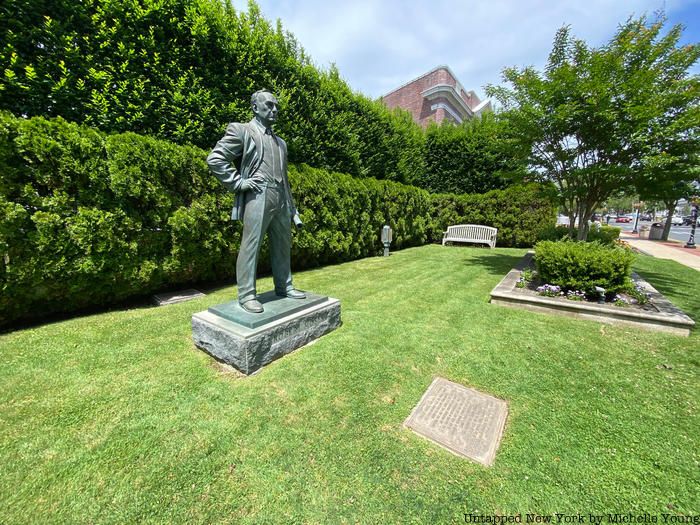
Moses had a weekend home in Babylon, Long island, described in a puff piece in the The Atlantic in 1931 as a “simple old house,” noting that “Moses’s inheritance helps him to live comfortably, but he is not wealthy, as is commonly supposed, and public service has involved many family sacrifices.”
In 2002, the Babylon Village Public Arts Commission, with funding from a Suffolk County grant, erected a statue of Robert Moses by the sculptor Jose Ismael Fernandez in front of the Babylon Village Town Hall, glorifying to such a level that the plaque may read like a parody to some. “Robert Moses, 1888-1981” the plaque reads, “was responsible for more buildings than any single person since the pharaohs ruled Egypt.” (This quote is derived partially from a eulogy by former New York Governor Herbert H. Lehman at Moses’ funeral in 1981). The plaque does mention that he was a “sometimes controversial force” but also that he was a “dominant” one who created “extraordinary public works in New York State and New York State.” It concludes with this sentence, half in the present tense, although the sculpture was installed more than twenty years after his death: “Moses is world renowned for creating the modern concepts of the state park and the super highway. With an eye to the future, Moses preserved the integrity of the Long Island shoreline while creating a legacy for future generations.”
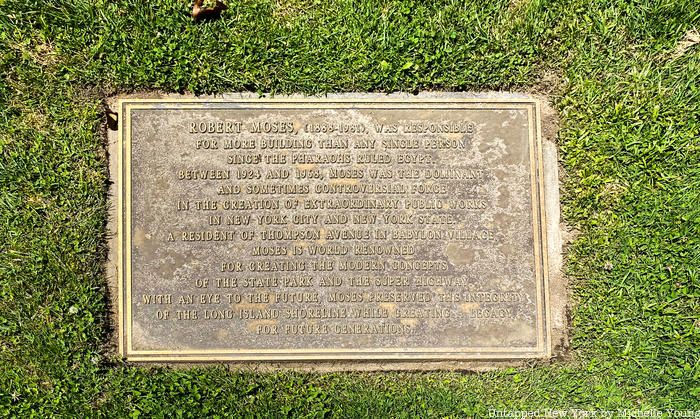
Moses wears a suit and tie and stands on two low pedestals, with his legs in a wide stance and his right elbow bent in a commanding posture. In his left hand, he holds a rolled document, presumably blueprints. The irony of the sculpture and plaque is manyfold. His current stature within the urban planning world has come into question in the last several decades, particularly with the staying power of The Power Broker, the quintessential biography written by Robert A. Caro in 1975 that has so frequently been placed in view on bookshelves in Zoom backgrounds during this pandemic. Moses was also portrayed as a master bully in the thinly-veiled character of Moses Randolph in the Edward Norton film, Motherless Brooklyn.
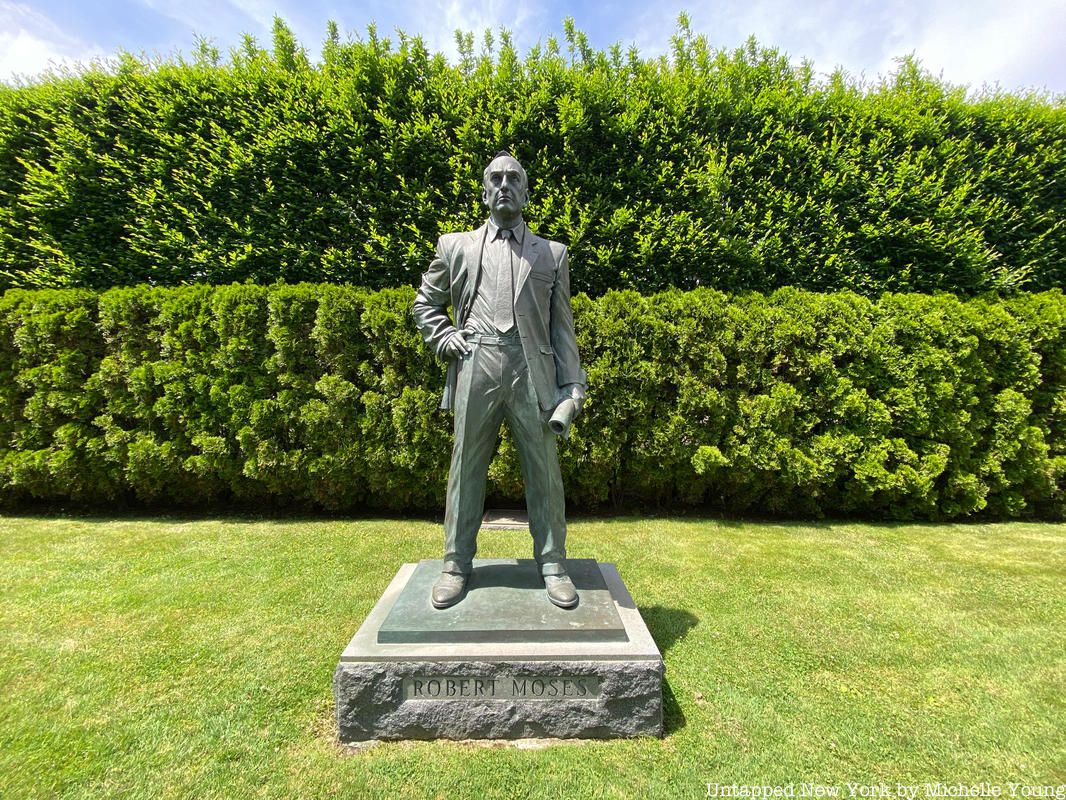
In New York City, Moses is not known for preserving the natural shoreline, but rather destroying it with garbage landfill to create things like the Belt Parkway. He left a legacy of public parks and pools for New Yorkers, but was also hell-bent on cutting through predominantly minority and low-income neighborhoods to build highways like the Cross Bronx Expressway, the Sheridan Expressway, and the thankfully never-built Lower Manhattan Expressway, a 10-lane highway that would have torn through Soho, Little Italy, and Washington Square Park in Greenwich Village. On Long Island, he is responsible for large projects like Jones Beach State Park and three of the main highways, the Northern State Parkway, Long Island Expressway, and the Southern State Parkway.
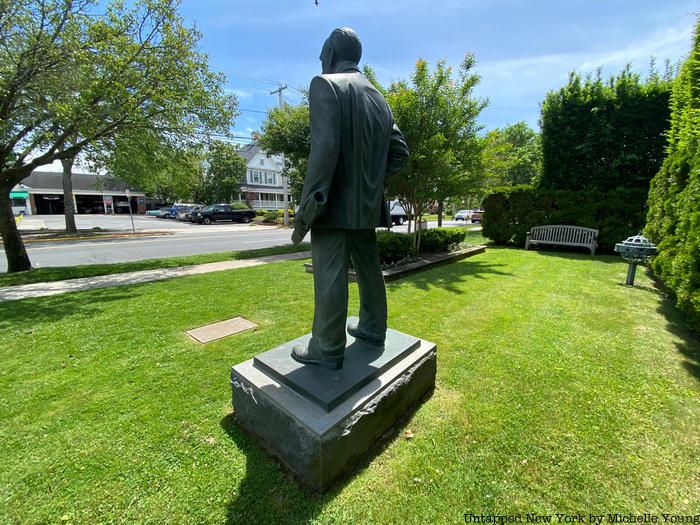
Robert Moses has not been immune to the recent calls to remove statues and memorials of people with histories of racism and prejudice. In Babylon, residents have been similarly advocating for the removal of a statue of Robert Moses and a petition started by Vanessa Cardino of Lindenhurst, Long Island now has over 12,600 signatures.
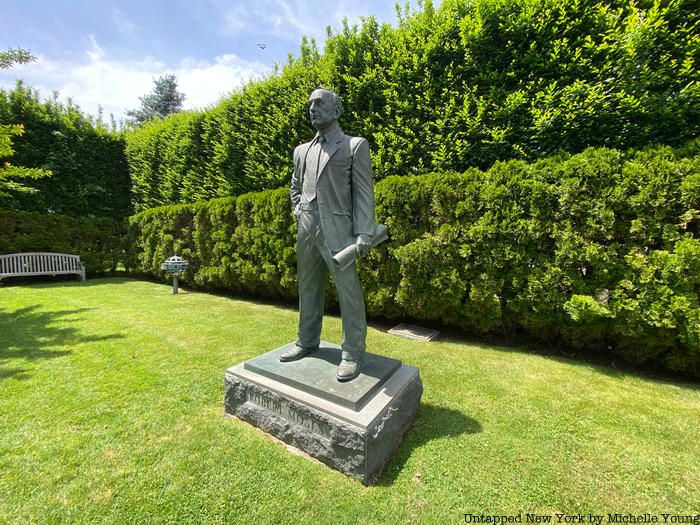
Cardino is a graduate of Fordham University and writes in the petition, “Robert Moses has left behind a long legacy of prejudice and gentrification, specifically targeting the Black and Jewish communities. Through his role in building infrastructure throughout Long Island, he supported tactics leading to housing segregation so Long Island neighborhoods were predominantly inhabited by White Christian folks. Yet, many still praise him for his work, calling him a ‘true visionary.'” Cardino also writes in the petition that the statue “represents a long history of systemic racism and anti-semitism” and should this be taken down.
It should be noted that Moses was born Jewish to German Jewish parents, but became an Episcopalian following college at Yale and some say he sought to distance himself from his Jewish roots. Yet according to one contemporary article, Moses is quoted as saying “I have never denied my Jewish descent.” We have not found any documented charges of anti-Semitism attributed to Moses, but the never-built Lower Manhattan Expressway would have cut through predominantly Jewish Lower East Side had it been built and the Cross-Bronx Expressway cut through what was “working-class, mostly Jewish neighborhood,” according to the book Roots for Radicals citing The Power Broker by Robert Caro. Moses’ well-documented biases (or at the very least, the outcome of his projects) predominantly impacted Black, Latino and low-income communities. Urban planner Alex Wallach tells us, “He was notoriously apathetic to all groups and neighborhoods that stood in his way.” The New York Times writes, “That Moses was highhanded, racist and contemptuous of the poor draws no argument even from the most ardent revisionists.” The petition also specifically calls out Moses’ role in building Lincoln Center after displacing communities of color in San Juan Hill, and Fordham University, which has a campus on the land next to Lincoln Center and has an outdoor plaza named for him.
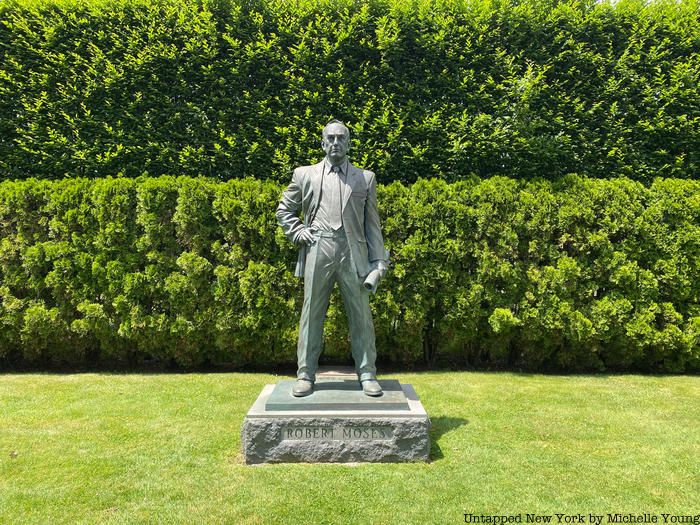
Nearby Babylon, there are more things named for Moses, including the Robert Moses Causeway which connects to Robert Moses State Park and Robert Moses Middle School. Perhaps we’ll see more petitions en route in the near future. Meanwhile, urban planner Alex Wallach who graduated from Robert Moses Middle School has an alternative suggestion: add a sculpture of Jane Jacobs, Fearless Girl-style across the street, he says, like when she was placed taunting the Wall Street Bull.
Next, check out 5 NYC Haunts of Robert Moses, as well as 5 Things We Can Blame on Robert Moses in NYC and 8 Things We Can Thank Robert Moses For.
Subscribe to our newsletter